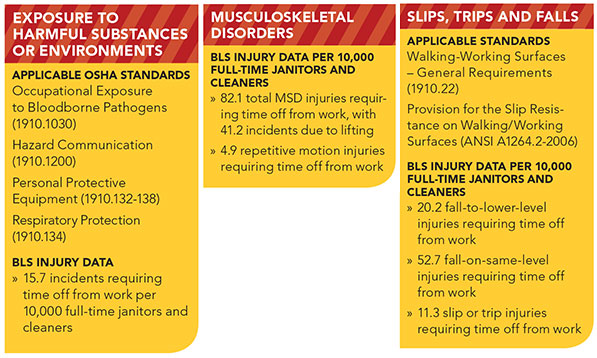Cleaning up safety
Janitors and cleaners face multiple hazards

KEY POINTS
- Cleaning supervisors and building management should be aware of respiratory and skin reactions to various chemicals, and in certain industries, the risk of bloodborne pathogens.
- Mentorship, hands-on training and using resources printed in multiple languages can help address training difficulties due to the demographics found in this occupation.
- Employers can avoid citations by following all applicable OSHA standards, such as hazard communication labeling and proper personal protective equipment use.
Without a janitor or building cleaner to disinfect objects and surfaces, repair lighting fixtures and perform maintenance on the environmental systems that make workspaces comfortable, employees’ workdays would be much more hazardous, unclean and unpleasant.
No employee may have a greater impact on a building’s safety and health environment than a janitor or cleaner, said John Poole, master registered executive housekeeper, Cleaning Industry Management Standard assessor and authorized OSHA outreach trainer.
Poole, who has worked for multiple commercial cleaning companies in addition to serving as an in-house cleaner and supervisor at organizations since 1973, advocates safety training for janitors and cleaners. According to the Bureau of Labor Statistics, in 2010, janitors and cleaners suffered more than 46,000 injuries requiring days away from work and had the 16th highest injury rate of all occupations.
Workers in this industry face a variety of both physical and environmental hazards. Because of this occupation’s high level of injury risk, supervisors and building management must take precautions to protect these workers from harm. Allen Rathey, president of the Boise, ID-based Healthy Facilities Institute (HFI), said training and standardizing procedures based on established laws and regulations are important to ensuring safety. “[An effective safety program] is the combination of training, handbooks, field application and classroom application training, and mindfulness of the ‘right-to-know’ laws,” he said. Right-to-know laws empower cleaners to understand the hazards of the chemicals they use in their jobs, he added.

Harmful exposure
Janitors and cleaners are exposed to powerful and potentially dangerous chemicals when using cleaning agents. OSHA requires chemical hazards to be communicated to workers through labels on containers, Material Safety Data Sheets and applicable employee training.
According to ISSA, a worldwide cleaning association headquartered in Lincolnwood, IL, one of the key injury concerns regarding chemical exposure is lung and nasal passage damage. Poole recalled an incident where a cleaner sniffed a bottle to identify its contents. The bottle contained ammonia, and the worker suffered severe mucus membrane damage and needed to be hospitalized. This emphasizes the importance of labeling all containers with applicable chemical information in addition to their risks and dangers, Poole said.
Another potential exposure concern for these workers involves infectious diseases. OSHA’s bloodborne pathogen guidelines mandate that employers have exposure control plans that list possible exposure scenarios and methods to reduce exposure risk, such as applicable personal protective equipment and procedures to reduce surface and object contamination. These regulations usually only apply to janitorial staff working in health care or certain education settings, according to ISSA.
Musculoskeletal disorders
Back injuries (about 46 percent) and shoulder injuries (about 15 percent) were the leading musculoskeletal disorder-causing injuries requiring time off work for janitors and cleaners in 2010, according to BLS.
An American Society of Safety Engineers report on hazards faced by janitors and cleaners offers several solutions to these common MSD injuries, which are often caused by overexertion and repetitive motions. The report recommended providing equipment that reduces the amount workers need to bend and stretch, such as long-handled and angled tools, and increasing use of battery-powered equipment. The report also suggested increasing the use of “no-touch” cleaning systems, which include movable tanks and carts of water or cleaning solutions that can be sprayed rather than applied manually.
Luis Romo, environmental service manager for Seattle-based Crista Senior Living, said that for years, his facility’s housekeepers complained about pain in their hands, wrists and backs. After conducting an assessment, he found that the heavy housekeeping carts the cleaners used – which had been used for 10 years at the facility – were causing strains. He eventually found a more ergonomically safe cart solution that he slowly implemented into the facility. In the year or so since the implementation, overall complaints about back, wrist and hand pain have significantly decreased, he said.
Slips, trips and falls
Cleaners deal with wet and slippery surfaces when mopping, waxing and scrubbing floors. Janitors often need to use ladders to reach lighting fixtures and other equipment for replacements and light repairs. As a result, slips, trips and falls cause some of the most serious and disabling injuries among building janitors and cleaners, according to ISSA.
OSHA’s Walking-Working Surfaces Standard (1910.22) establishes that passageways and storerooms used by cleaners and all other workers must be free of obstacles and other hazards. The American National Standards Institute A1264.2-2006 standard mandates the use of signage and other warning devices for locations where trip and slip hazards are present. It also mandates the use of slip-resistant footwear and training procedures to ensure workers maintain safe walking speeds.
One of the most common workers’ compensation claims in the hospitality industry involves slips while cleaning restrooms, according to Stephen Barth, attorney, professor of hospitality law and leadership at the University of Houston Conrad Hilton College, and founder of HospitalityLawyer.com. As a solution, he recommends hotels and contractors provide their cleaners with longer tools to reach and scrub, and cautions workers to not stand in bathtubs when cleaning shower areas.
Post a comment to this article
Safety+Health welcomes comments that promote respectful dialogue. Please stay on topic. Comments that contain personal attacks, profanity or abusive language – or those aggressively promoting products or services – will be removed. We reserve the right to determine which comments violate our comment policy. (Anonymous comments are welcome; merely skip the “name” field in the comment box. An email address is required but will not be included with your comment.)

